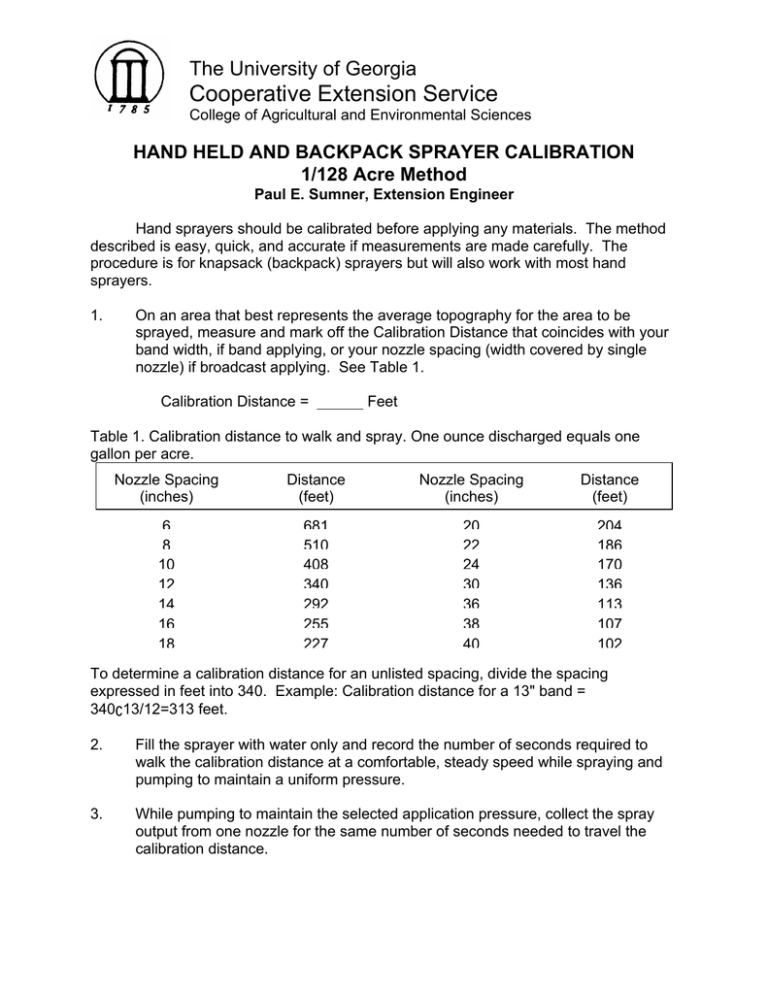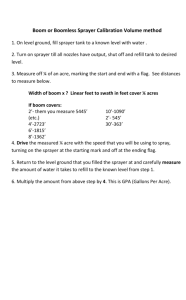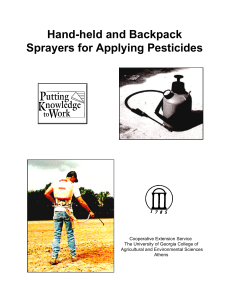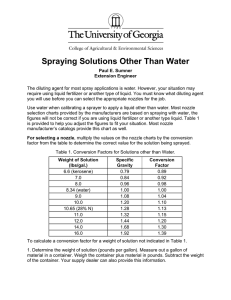Cooperative Extension Service The University of Georgia
advertisement

The University of Georgia Cooperative Extension Service College of Agricultural and Environmental Sciences HAND HELD AND BACKPACK SPRAYER CALIBRATION 1/128 Acre Method Paul E. Sumner, Extension Engineer Hand sprayers should be calibrated before applying any materials. The method described is easy, quick, and accurate if measurements are made carefully. The procedure is for knapsack (backpack) sprayers but will also work with most hand sprayers. 1. On an area that best represents the average topography for the area to be sprayed, measure and mark off the Calibration Distance that coincides with your band width, if band applying, or your nozzle spacing (width covered by single nozzle) if broadcast applying. See Table 1. Calibration Distance = Feet Table 1. Calibration distance to walk and spray. One ounce discharged equals one gallon per acre. Nozzle Spacing (inches) Distance (feet) Nozzle Spacing (inches) Distance (feet) 6 8 10 12 14 16 18 681 510 408 340 292 255 227 20 22 24 30 36 38 40 204 186 170 136 113 107 102 To determine a calibration distance for an unlisted spacing, divide the spacing expressed in feet into 340. Example: Calibration distance for a 13" band = 340_13/12=313 feet. 2. Fill the sprayer with water only and record the number of seconds required to walk the calibration distance at a comfortable, steady speed while spraying and pumping to maintain a uniform pressure. 3. While pumping to maintain the selected application pressure, collect the spray output from one nozzle for the same number of seconds needed to travel the calibration distance. Example: With a 30 inch band, if it took 28 seconds to travel 136 feet, collect the nozzle discharge for 28 seconds. THE NUMBER OF FLUID OUNCES COLLECTED EQUALS THE GALLONS PER ACRE (GPA) Example: 16 ounces collected equals 16 GPA 4. If using a boom, repeat step 3 two more times, collecting water from a different nozzle each time. The average number of ounces collected for each of the three nozzles is equal to the gallons of water applied per acre for that boom, speed, and pressure. 5. To determine the amount of chemical to add to the spray tank, divide the capacity of the tank by the number of gallons of water per acre (GPA) to determine the fraction of an acre that can be covered with a tankful of spray. Example: 3 gallon tank divided by 16 GPA = 0.188 acre covered per tank 6. Multiply the application rate of the product per acre times the fraction of the acre covered per tank and add that amount of chemical to the sprayer tank. Example: 2 qts. per acre = 64 fl. oz. per acre x 0.188 acre per tank = 12 fl. oz. per tank. Example: 5 lb. per acre x .188 acre per tank =0.94 Ib. per tank x 16 = 15 oz.(by weight) per tank. Uniform Application Check Hand sprayers require skilled operators to achieve a uniform broadcast application. A simple and quick test is to spray an area on a paved surface with water in your normal spraying manner on a warm day. In a few minutes the drying pattern will indicate your distribution. Fast drying areas indicate low application rates while slow drying areas received high amounts of spray. Uniform drying without streaks indicates uniform application. Practice until uniform distribution is obtained. The University of Georgia and Ft. Valley State College, the U.S. Department of Agriculture and Counties of the state Cooperating. The Cooperative Extension Service offers educational programs, assistance and materials to all people without regard to race, color, national origin, age sex or disability. An Equal Opportunity/affirmative Action Organization Committed to a Diverse Work Force Engineering Issued in furtherance of Cooperative Extension work, Acts of May 8 and June 30, 1914, The University of Georgia College of Agriculture and the U. S. Department of Agriculture cooperating. Gale A. Buchanan, Dean and Director




